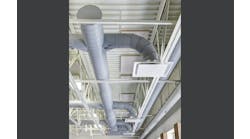Historically, window film has been used to reduce temperatures in buildings prone to overheating. Too much solar energy entering through windows makes occupants uncomfortable and air conditioning more costly. Film has been a simple solution for a simple problem.
But the environmental issues facing school buildings extend beyond overheating and energy conservation. Many measures intended to increase energy efficiency — such as “tightening” buildings to reduce air infiltration and outflow — have led to negative impacts on indoor environmental and air quality. Sick-building syndrome threatens building occupants and can result in costly lawsuits.
School building designers must address issues such as under-ventilated and circulated air, moisture and mold growth, offgassing of furniture and building components, and how such conditions affect the productivity and well-being of students, faculty and staff.
Film's role
Windows and fixed glass allow the relatively easy transmission of heat and light into a building's interior. Glass will continue to be a significant part of a school building's envelope because daylight has been shown to improve student performance and well-being. Architects and facility managers should understand how glass performs in terms of heat and light.
For instance, according to the California Energy Commission, heat entering through existing windows accounts for 30 percent of a building's cooling requirements. Reducing heat in a building usually is considered to be an HVAC function, but stopping heat at the window with heat-blocking window film can reduce air-conditioning costs, and placate many students and staff who believe “conditioned” air is less desirable than non-conditioned air.
At Stanford University's Encina Hall, about 6,212 square feet of spectrally selective window film was applied in June 2003. Spectrally selective film blocks solar heat while transmitting high levels of natural light.
Daily air conditioning (A/C) requirements to remove heat at Encina Hall prior to the film's installation amounted to 665.57 A/C tons at an A/C cost of $66.56 per day. Daily air-conditioning requirements to remove heat with the film installed are 339.44 A/C tons at an A/C cost of $33.94 per day. As a result of the film's installation, Encina Hall is seeing an annual savings in A/C cost of $4,891.95.
Anecdotal evidence suggests that air conditioning aggravates the effects of arthritis and neuritis, and makes some people sick because of the extreme variances between outside and inside temperatures.
IAQ and heat
Offgassing — fumes released from products such as carpet or furniture — results from molecular motion; the greater the heat, the more offgassing that will occur.
So, as the temperature of a room increases, carpeting, glue used in furniture and various chemicals in building materials will release more fumes.
Schools don't have to rely entirely on HVAC systems to reduce offgassing; window film can do much of the job — at a lower cost and without subjecting students, faculty and staff to prolonged “conditioned” air.
The presence of mold is caused by moisture inside a building. Humid interiors will breed mold, and warmer interiors are a more hospitable environment for mold.
Reducing interior temperatures supportive of mold growth need not depend entirely on HVAC systems. Less costly window film can shoulder much of the burden.
If window film reduces indoor temperatures without the need for extensive reliance on expensive “conditioned” air, should schools choose the window film that blocks the most heat? Not necessarily.
Tinted film blocks heat by absorption. Reflective film, which sometimes appears mirrored, reflects heat. Some of these films block heat better than others, but all, to one degree or another, are unable to transmit significant levels of natural light.
In some cases, window films with metallized heat-reflective coatings block as much as 85 percent of the visible light outside from entering the inside of a building.
This may detract from indoor air quality; the window film may block so much natural light that it darkens building interiors, causing facilities to use more artificial light and generate more heat. And in many buildings, that means more air conditioning, which defeats the purpose of installing heat-reducing window film.
Inhibiting natural light also may hinder building occupants' productivity and well-being. Studies by the California Energy Commission, the U.S. Department of Energy, the Rocky Mountain Institute and the Lighting Research Center at the Rensselaer Polytechnic Institute document a relationship between low levels of natural light and less than optimum performance on the part of building occupants.
Spending significant time in unnaturally dark spaces (and even spaces with adequate artificial illumination but limited natural light) causes people to feel less energized. They often suffer more illness, take more sick days and are less productive than those in naturally illuminated environments.
Some window films will block significant amounts of solar heat without reducing desired levels of natural light. Spectrally selective film transmits natural light while blocking the heat that can exacerbate offgassing, mold formation and sick-building syndrome.
The use of clear, spectrally selective applied film will not negate energy savings, compared with those reflective films that block more heat.
The Los Angeles Department of Water and Power's (LADWP) rebate program for window film is based on a film's luminous efficacy constant — a measurement of its ability to block heat and transmit light simultaneously. A very reflective film that blocks more heat than a spectrally selective film earns a $0.55 per square foot rebate from LADWP; however, a spectrally selective film that blocks less heat while admitting more light receives a higher rebate of $0.85 per square foot.
Only spectrally selective films with luminous efficacy constants more than 1.0 receive the higher rebate.
No silver bullet
Those responsible for designing a school building realize that no single program component constitutes a silver bullet. In that regard, window film no more can do the job alone than can overburdened HVAC systems.
In reality, the quality of the environment depends on several initiatives. They include selecting furnishings and building components that will not offgas, and preventing the formation of condensation and humidity in sufficient amounts to cause mold. Effectively managing a building's environment also should rely on an adequate HVAC system aided by appropriate heat-blocking window film and other relevant methods to save energy and enhance environmental quality.
NOTABLE
30
Percentage of a building's cooling requirements taken up by heat entering through existing windows.
Source: California Energy Commission
Watts is president and CEO of V-Kool, Inc., Houston, a sales and marketing distribution company of window films.
